1.3 billion year old dark blue iron ore from the Hamersley region. Photo by Liam Courtney-Davies, Curtin University
According to a study led by Curtin University, the largest iron ore deposit on Earth is Hamersley County Fossils of a deep-sea volcano hidden beneath the ocean floor of Western Australia are about a billion years newer than previously thought, and the discovery could greatly accelerate the search for further resources.
Using a new geological dating technique that precisely dates iron oxide minerals, the researchers discovered that the Hammersley deposit formed between 1.4 and 1.1 billion years ago, rather than the 2.2 billion years previously estimated.
Lead author Dr Liam Courtney-Davies was a postdoctoral research fellow at the John de Laeter Centre, Curtin University at the time. the study The find suggests that the iron deposits formed during a period of major geological activity, when ancient supercontinents were breaking apart and new continents were forming, said Dr. Schneider, now at the University of Colorado Boulder.
” energy “This spectacular geological event is likely to have triggered the creation of billions of tonnes of iron-rich rocks across the Pilbara,” Dr Courtney Davis said.
“The discovery of these giant iron ore deposits and their connection to changing supercontinent cycles advances our understanding of ancient geological processes and improves our ability to predict where to explore in the future.”
Study co-author Associate Professor Martin Danisik, from the John de Laeter Centre, said the research accurately determined the age of the banded minerals. Iron ore (BIFs) are ancient iron-rich ocean floor rock formations that can provide important insights into the Earth’s deep geological past.
“Until now, it was unclear exactly when these formations changed from their original 30 percent iron content to more than 60 percent iron today, which has hindered our understanding of the processes that led to the formation of the world’s largest mineral deposits,” Associate Professor Danisik said.
“By using new techniques to date iron oxide minerals through uranium and lead isotope analysis, mineral Grains were used to directly date all of the major large BIF-bearing iron ore deposits in Hamersley County.
“Our study shows that these deposits formed in conjunction with major tectonic events, highlighting the dynamic nature of Earth’s history and the complexity of iron ore mineralization.”
Western Australia is one of the world’s largest producers of iron ore, with exports worth $131 billion last year, making it Australia’s largest exporter. The study was carried out in collaboration with researchers from the University of Western Australia, Rio Tinto and CSIRO’s Mineral Resources Institute.
The full study, titled “One Billion Years of Change in the Formation of Earth’s Largest Mineral Deposits,” Proceedings of the National Academy of Sciences.
For more information:
Courtney Davis, Liam, A Billion Years of Change in the Formation of Earth’s Largest Mineral Deposits, Proceedings of the National Academy of Sciences (2024). Translation: 10.1073/pnas.2405741121. doi.org/10.1073/pnas.2405741121
Provided by
Curtin University
Quote: New Date for Earth’s Largest Iron Deposits Offers Clues for Future Exploration (July 22, 2024) Retrieved July 23, 2024 from https://phys.org/news/2024-07-date-earth-largest-iron-deposits.html
This document is subject to copyright. It may not be reproduced without written permission, except for fair dealing for the purposes of personal study or research. The content is provided for informational purposes only.


